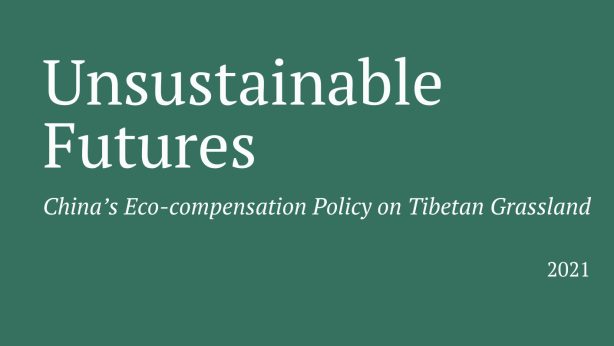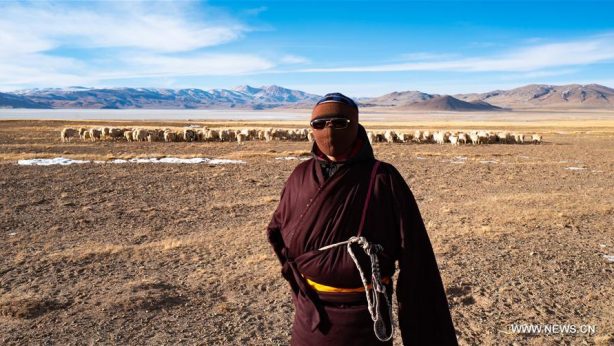Tibetan Advocacy at #COP26: A just and sustainable climate action backed by a human rights-based approach
Tibet experiences rapid climate change that damages glaciers, cause floods and lake overtopping, melts permafrost, compromises livelihoods, and dries wetlands essential to the East Asian flyway routes of seasonally migrating birds, threatening extinction. Warmer and wetter makes Tibet more like China, which is good from China’s point of view.
The official China Meteorological Administration says of Tibet: “[I]t is not so dry and cold, the lake area is larger, and even the Gobi has begun to grow green. With a warmer and wetter climate, the ecological environment of the Qinghai-Tibet Plateau has been improved. Plateau area is greener, the air is more humid, the production of forage grass has increased, the living space of wild animals has expanded, and the plateau looks more beautiful.” China sees this as a dividend of climate change.
Although Tibet and the Tibetans have little to no role in causing the rapid rise in methane emissions, rainfall, ozone hole above Tibet, or the rising runoff from Tibetan rivers, China, immediately downstream, harvests a dividend of extra runoff at least as long as it may take for the glaciers to disappear.
China is the world’s biggest emitter of climate heating gases, the biggest maker of steel, aluminium, copper, and other metals, consumes more coal than the rest of the world combined, yet makes no commitment to any reduction in emissions, until 2030, well after other countries have started to decarbonise.
China is also rapidly increasing coal mining for electricity generation, the opposite of what it says it intends long term. The Climate Action Tracker rates China’s climate commitments as “highly insufficient.” If China continues on its current path, we are headed for a global temperature rise of three degrees.
China persists with economic stimulus payments that incentivise and subsidise energy-intensive investments, inconsistent with effective action in this decade to make net-zero feasible by 2060.
China’s pledge to reach net-zero emissions by 2060 is a full decade later than any other country. Net-zero does not mean zero-emission. China plans to be as wealthy as any of the rich nations by 2049. That means high consumption of every resource the planet can provide. Carbon emissions will persist, especially in industries where there are no alternatives, such as shipping and air travel.
Net zero means somewhere outside the cities and megapolis, land agglomerations have to make up for those emissions by being a carbon sink. That is what China has planned for Tibet: repurpose most of the plateau as national parks, with no ongoing human use other than mass tourism destination management.
China plans to further intensify urbanisation, which further extracts water and resources from remote areas to feed city demand. China is officially committed to attaining equality of wealth and consumption on par with the richest nations, which is unsustainable, imposing on the whole planet a footprint that is unbearable.
China plans to rely on non-existent technologies such as carbon sequestration to reduce emissions while persisting with coal-burning on a staggering scale far into the future.
Illegal manufacture of banned ozone-depleting chemicals persists in China, contrary to the Montreal Protocol, and China’s efforts to enforce its own laws are` failing, with dire consequences in Tibet of increased mutagenic UV radiation that harms all sentient beings.
China’s emissions trading scheme is moribund, failing to set a meaningful price on carbon, thus no payments for ecosystem services reach the rural Tibetan local communities who do the actual work of ecosystem equilibrium maintenance.
China is heavily reliant on market-based schemes to mitigate emissions, with almost no evidence that they achieve anything. Yet local communities in remote areas that do sequester more carbon by ceasing their grazing and losing land tenure security, are required to end rural life permanently, to guarantee the long-term monetary value of carbon credits purchased by emitters.
As a new report shows, Tibet is immediately upriver, upwind and upland of China, a provider of ecosystem services on a huge scale, yet Tibetans are not compensated for the opportunity cost incurred for foregoing development, in order to continue provisioning of ecosystem services beneficial to China.
China imports from Tibet enormous quantities of clean water, clean air, minerals, and electricity, yet Tibetans are marginalised, silenced, racially stigmatised, and not acknowledged as providers of ecosystem services.
Eco-compensation, China’s version of payment for ecosystem services, relocates nomads out of their pastures and into urban modernity, an official policy backed by legislation and regulations, even down to rules stipulating vehicles are forbidden to traverse roadless meadows, yet exempts the buses sent to remove nomads from their nomad lands.
Depopulating Tibet of its landscape custodians and livestock producers weakens Tibetan food security, in direct contravention of China’s national food security policies, and human rights embedded in the Sustainable Development Goals.
The Tibetan Plateau is a major driver of the planetary wave resonance that increasingly causes heatwaves, droughts, and floods, due to the slowing and wandering of the jet stream. Tibet’s high altitude routinely deflects the jet stream to the south of the plateau in summer and to the north of the plateau in winter. That wavy meandering of the jet stream impacts the entire northern hemisphere, igniting wildfires, cold snaps, and floods. Tibet is crucially important, and therefore, addressing climate issues faced by Tibetans is indispensable for a sustainable future for the world.


